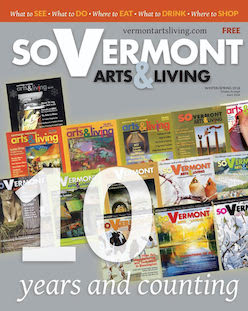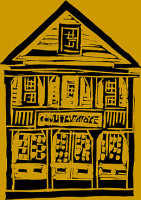David Gil
The Legacy of David Gil Celebrated in Bennington
Tradition, Innovation, and Good Design: The Ceramics of David Gil at the Bennington Museum
By Anita Rafael
Through May 17, 2009, the first major retrospective of David Gil’s work showing the variety of ceramic products designed by Gil and produced by Bennington Potters over a period of more than 50 years. The exhibition features never-before-exhibited works created by Gil from 1948 through the 1970s.
The Legacy of David Gil Celebrated in Bennington
Tradition, Innovation, and Good Design: The Ceramics of David Gil at the Bennington Museum
By Anita Rafael
 Through May 17, 2009, the first major retrospective of David Gil’s work showing the variety of ceramic products designed by Gil and produced by Bennington Potters over a period of more than 50 years.The exhibition features never-before-exhibited works created by Gil from 1948 through the 1970s. Drawn from important local private collections, David Gil’s family, and the museum’s own permanent collection, the exhibition includes beautiful examples of Gil’s art pottery as well as his more familiar work as a production designer.
Through May 17, 2009, the first major retrospective of David Gil’s work showing the variety of ceramic products designed by Gil and produced by Bennington Potters over a period of more than 50 years.The exhibition features never-before-exhibited works created by Gil from 1948 through the 1970s. Drawn from important local private collections, David Gil’s family, and the museum’s own permanent collection, the exhibition includes beautiful examples of Gil’s art pottery as well as his more familiar work as a production designer.
One day weeks before the opening of a new ceramics exhibition at the Bennington Museum opened, Sheela Harden made trip after careful trip through the front door of that venerable granite-walled institution, her arms cradling pottery pieces by her late husband, David Gil. She then carried in three different electric lanterns made by Gil more than 40 years ago. Despite their age and old, brittle wiring, the lamps glowed softly as Harden tested each one in an outlet in the museum’s lobby. More of Gil’s ceramic creations delivered by Harden that day included a greenishblack coin bank in the shape of a life-sized cat and a large, white jar, its lid still intact. Gently lining up the pieces on an old wooden bench by the museum’s reception desk, Harden inadvertently created an impromptu art show of striking ceramic works, treasured pieces she hoped others would enjoy and study. That afternoon, museum curator Jamie Franklin inspected each piece, asking Harden about manufacture dates and looking for Gil’s incised signature or back stamp. In the end, Franklin asked to borrow all of the items for the first retrospective of David Gil’s work, an exhibit that opened at the Bennington Museum in mid-March. For months prior to Harden’s visit, Franklin had been contacting private collectors in Vermont and other states to request loans of Gil’s work so that he could assemble the ceramics show. Bringing the exhibit’s number of pieces to nearly 200, Harden’s loans would add much, Franklin knew, to the impact of the Gil retrospective, an important show for the Bennington Museum.
Few people outside of Bennington know that the town was once a prosperous ceramics center, and fewer still are aware of how extremely valuable the goods from the old manufacturers are today. The Norton Pottery was founded in Bennington by Captain John Norton in 1785 and operated until the mid-1800s. Five summers ago, one Norton five-gallon crock, circa 1855, sold at auction for a remarkable $23,650, despite the fact that the 13-inch tall piece was visibly chipped and had a hairline crack. A smaller, four-gallon Norton preserve jar of the same date brought $9,350 at that sale. Norton was credited with mechanizing aspects of pottery production in the early 19th century. Another Bennington ceramics business, Christopher Webber Fenton’s United States Pottery Company, employed as many as 200 potters and workers and went on to patent several technical achievements. It was the first pottery in America to produce a fine-grade porcelain called Parian. The company, and hence the town of Bennington, claimed international fame in 1853 when it sent a tenfoot high columned pedestal, topped with the Madonna and Christ child, to America’s first World’s Fair in New York. (The mammoth ceramic, which was displayed at the Crystal Palace exhibition, is now in the collection of the Bennington Museum.)
 Two galleries in the Bennington Museum that comprise a ceramics study center displaying hundreds of examples of Norton, Fenton and other historical pieces made in town are located beside the two spaces now containing Gil’s modern work. The proximity of old and new visually completes the timeline of Bennington’s ceramics industry. Together, the rooms clearly demonstrate that what started in Colonial times by no means ended when the town’s earliest pottery businesses declined in the late 19th century and soon afterward closed; Gil’s design concepts and the way he ran his business carried both the traditions and the innovations forward.
Two galleries in the Bennington Museum that comprise a ceramics study center displaying hundreds of examples of Norton, Fenton and other historical pieces made in town are located beside the two spaces now containing Gil’s modern work. The proximity of old and new visually completes the timeline of Bennington’s ceramics industry. Together, the rooms clearly demonstrate that what started in Colonial times by no means ended when the town’s earliest pottery businesses declined in the late 19th century and soon afterward closed; Gil’s design concepts and the way he ran his business carried both the traditions and the innovations forward.
Born David Goldfarb in 1922 in New York to immigrant parents, Gil grew up in Harlem, a multi-ethnic neighborhood in the New York City borough of Manhattan. He took art and pottery classes in high school and was soon producing ceramics under the auspices of President Roosevelt’s arts-friendly Works Progress Administration. Although still a teenager, he was hired to sit at a wheel and throw pots in public as a craft demo for visitors to the World’s Fair in New York in 1939. He was enrolled from 1940 to ’42 and again from 1946 to ’48 at the New York State College of Ceramics at Alfred University. (In the intervening war years, he served as a merchant seaman.) With his first wife Gloria, he moved to Bennington after graduating, with plans to start a design studio. It was at this time that he changed his surname, perhaps to better blend into life in a traditional New England village. Design discovery through artistic collaboration was a driving force for Gil as he began his career, and in its first phase, the business (housed in an unheated barn) was the creative effort of a group of modern designers. They originally called the enterprise Cooperative Design, which Gil later changed to Bennington Potters. Gil won many national awards during the 1950s, and his works were exhibited internationally. In 1959 Gil’s tableware lines were picked up by Raymor, wellknown New York distributors of modern domestic products. (The company was also known as Richards, Morgenthau & Co.) Gil moved Bennington Potters to its current site on County Street, taking exceptional delight, recounts Harden, in rehabilitating forlorn wooden and brick supply buildings adjacent to a railroad spur. The complex grew to be a vast design showcase for Bennington’s production wares.
In the mid-60s, Gil’s was still in the news in major art periodicals. He was producing affordable limited edition ceramic items designed by some of America’s most famous mid-20th century artists. Despite little success with massmarketing the venture, Gil’s creative concepts placed him among the design trendsetters of the day. By the 1970s, wares from Bennington Potters were coveted and in many ways already legendary. The range of items designed and created by Gil during more than a half-century in his studio — including art pieces, prototypes, transition pieces and production runs of what would become Bennington’s “best sellers” — is nearly beyond cataloging. According to Harden, even the numbering system that the company began in the 1960s does not fully document or inventory the volume of work. Sheela Harden assumed her late husband’s corporate role as president and CEO of Bennington Potters after his unexpected death seven years ago. Still adhering to his philosophy of collaborative design, Harden works closely with talented ceramic artists and designers who are, as is she, fiercely loyal to Gil’s purpose. It is very likely the reason behind their continued success. 
The exhibition at the Bennington Museum brings to light lesser known and subtle aspects of Gil’s talent, confirming his significant role in the evolution of modern ceramics. Curator and exhibit designer Jamie Franklin includes Gil’s “slick designs” from the early years. Franklin notes that some of Gil’s “biomorphic pieces” brought him national recognition; Gil was included in important shows such as the “Good Design” exhibitions, co-organized by the Museum of Modern Art in New York and Merchandise Mart in Chicago, as well as the “Young Designer” exhibition at Ohio’s Akron Museum. Franklin opted to include Gil’s whimsical tiles and animal-form banks from the 1960s and ’70s. He also highlights the well-designed, exceptionally popular and highly functional sets of dishes, some artfully arranged on tables as if set out for dinner. The retrospective show reflects visually the words in Gil’s death notice, which appeared in the New York Times in March, 2002, and summarized the artist’s motivations: “His satisfaction was problem solving, and his greatest pleasure was seeing his own designs out in the world, both in the marketplace and in people’s hands being used every day. David’s legacy is the Bennington Pottery brand, and his memory is an icon to craft producers; he was a man who made a business from his art.”






















































